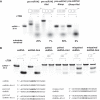Tudor staphylococcal nuclease is a structure-specific ribonuclease that degrades RNA at unstructured regions during microRNA decay
- PMID: 29440319
- PMCID: PMC5900569
- DOI: 10.1261/rna.064501.117
Tudor staphylococcal nuclease is a structure-specific ribonuclease that degrades RNA at unstructured regions during microRNA decay
Abstract
Tudor staphylococcal nuclease (TSN) is an evolutionarily conserved ribonuclease in eukaryotes that is composed of five staphylococcal nuclease-like domains (SN1-SN5) and a Tudor domain. TSN degrades hyper-edited double-stranded RNA, including primary miRNA precursors containing multiple I•U and U•I pairs, and mature miRNA during miRNA decay. However, how TSN binds and degrades its RNA substrates remains unclear. Here, we show that the C. elegans TSN (cTSN) is a monomeric Ca2+-dependent ribonuclease, cleaving RNA chains at the 5'-side of the phosphodiester linkage to produce degraded fragments with 5'-hydroxyl and 3'-phosphate ends. cTSN degrades single-stranded RNA and double-stranded RNA containing mismatched base pairs, but is not restricted to those containing multiple I•U and U•I pairs. cTSN has at least two catalytic active sites located in the SN1 and SN3 domains, since mutations of the putative Ca2+-binding residues in these two domains strongly impaired its ribonuclease activity. We further show by small-angle X-ray scattering that rice osTSN has a flexible two-lobed structure with open to closed conformations, indicating that TSN may change its conformation upon RNA binding. We conclude that TSN is a structure-specific ribonuclease targeting not only single-stranded RNA, but also unstructured regions of double-stranded RNA. This study provides the molecular basis for how TSN cooperates with RNA editing to eliminate duplex RNA in cell defense, and how TSN selects and degrades RNA during microRNA decay.
Keywords: RNA editing; RNA silencing; TSN; microRNA decay; ribonuclease.
© 2018 Li et al.; Published by Cold Spring Harbor Laboratory Press for the RNA Society.
Figures






Similar articles
-
Tudor-SN-mediated endonucleolytic decay of human cell microRNAs promotes G1/S phase transition.Science. 2017 May 26;356(6340):859-862. doi: 10.1126/science.aai9372. Science. 2017. PMID: 28546213 Free PMC article.
-
Structural and functional insights into human Tudor-SN, a key component linking RNA interference and editing.Nucleic Acids Res. 2008 Jun;36(11):3579-89. doi: 10.1093/nar/gkn236. Epub 2008 May 3. Nucleic Acids Res. 2008. PMID: 18453631 Free PMC article.
-
Penaeus monodon Tudor staphylococcal nuclease preferentially interacts with N-terminal domain of Argonaute-1.Fish Shellfish Immunol. 2013 Mar;34(3):875-84. doi: 10.1016/j.fsi.2012.12.012. Epub 2013 Jan 18. Fish Shellfish Immunol. 2013. PMID: 23333357
-
Tudor staphylococcal nuclease: biochemistry and functions.Cell Death Differ. 2016 Nov 1;23(11):1739-1748. doi: 10.1038/cdd.2016.93. Epub 2016 Sep 9. Cell Death Differ. 2016. PMID: 27612014 Free PMC article. Review.
-
Plant dicer-like proteins: double-stranded RNA-cleaving enzymes for small RNA biogenesis.J Plant Res. 2017 Jan;130(1):33-44. doi: 10.1007/s10265-016-0877-1. Epub 2016 Nov 24. J Plant Res. 2017. PMID: 27885504 Review.
Cited by
-
Viral proteins suppress rice defenses by boosting OsTSN1 RNA decay via phase separation and multimerization.Nat Commun. 2025 Aug 12;16(1):7481. doi: 10.1038/s41467-025-62395-5. Nat Commun. 2025. PMID: 40796552 Free PMC article.
-
Circular RNA METTL9 contributes to neuroinflammation following traumatic brain injury by complexing with astrocytic SND1.J Neuroinflammation. 2023 Feb 17;20(1):39. doi: 10.1186/s12974-023-02716-x. J Neuroinflammation. 2023. PMID: 36803376 Free PMC article.
-
The RNA-binding protein Snd1/Tudor-SN regulates hypoxia-responsive gene expression.FASEB Bioadv. 2023 Feb 21;5(5):183-198. doi: 10.1096/fba.2022-00115. eCollection 2023 May. FASEB Bioadv. 2023. PMID: 37151849 Free PMC article.
-
Insights Into SND1 Oncogene Promoter Regulation.Front Oncol. 2018 Dec 11;8:606. doi: 10.3389/fonc.2018.00606. eCollection 2018. Front Oncol. 2018. PMID: 30619748 Free PMC article. Review.
-
Modified base-binding EVE and DCD domains: striking diversity of genomic contexts in prokaryotes and predicted involvement in a variety of cellular processes.BMC Biol. 2020 Nov 4;18(1):159. doi: 10.1186/s12915-020-00885-2. BMC Biol. 2020. PMID: 33148243 Free PMC article.
References
-
- Abe S, Wang PL, Takahashi F, Sasaki E. 2005. Structural analysis of cDNAs coding for 4SNc-Tudor domain protein from fish and their expression in yellowtail organs. Marine Biotechnol (NY) 7: 677–686. - PubMed
-
- Cappellari M, Bielli P, Paronetto MP, Ciccosanti F, Fimia GM, Saarikettu J, Silvennoinen O, Sette C. 2014. The transcriptional co-activator SND1 is a novel regulator of alternative splicing in prostate cancer cells. Oncogene 33: 3794–3802. - PubMed
-
- Caudy AA, Ketting RF, Hammond SM, Denli AM, Bathoorn AM, Tops BB, Silva JM, Myers MM, Hannon GJ, Plasterk RH. 2003. A micrococcal nuclease homologue in RNAi effector complexes. Nature 425: 411–414. - PubMed
Publication types
MeSH terms
Substances
LinkOut - more resources
Full Text Sources
Other Literature Sources
Miscellaneous
